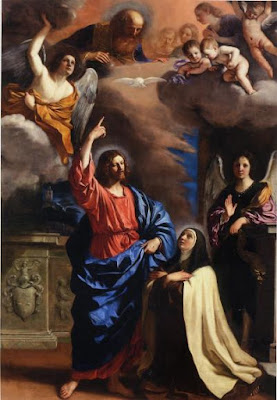 |
| Guercino (Giovanni Francesco Barbieri) Christ appearing to St Teresa 1634 oil on canvas Musée Granet, Aix-en-Provence |
 |
| Guercino (Giovanni Francesco Barbieri) Christ appearing to St Teresa 1634 drawing (compositional study) Royal Library, Windsor |
 |
| Guercino (Giovanni Francesco Barbieri) Christ appearing to St Teresa 1634 drawing (compositional study) Musée des Beaux-Arts, Angers |
 |
| Guercino (Giovanni Francesco Barbieri) Christ appearing to St Teresa 1634 drawing (figure study) Pinacoteca Civica, Cento |
 |
| Gilles Rousselet after Guercino Christ appearing to St Teresa ca. 1650 engraving Metropolitan Museum of Art, New York |
"[Carlo Cesare] Malvasia listed the picture under the year 1634 and said that it represented Christ showing St Teresa the glory of Paradise. The painting was commissioned by the financier and merchant Barthélemy Lumague (d. 1641) – Malvasia called him 'Gio. Lumaga' – to decorate the family chapel in the convent church of the Discalced Carmelites, Lyon. The deposit of 100 ducats (131 ½ scudi) was paid on 5 January 1634 by Ludovico Mastri, a local banker, and the balance of 300 ducats (405 scudi) was paid by him (on behalf of Barthélemy Lumague) on 18 August of the same year. [Stéphane] Loire suggested that Lumague had offered to act as banker for Maria de' Medici for her proposed purchase of Guido Reni's Rape of Helen, a deal that collapsed after she fled from France in 1631. Probably through Cardinal Spada, Guercino and Lumague were put into contact with each other."
 |
| Guercino (Giovanni Francesco Barbieri) Allegory of Faith ca. 1634 oil on canvas Pushkin State Museum, Moscow |
 |
| Guercino (Giovanni Francesco Barbieri) Baptism of Christ (lost painting) 1634 drawing (compositional study) Teylers Museum, Haarlem |
"Though Malvasia did not mention a picture of this subject commissioned from Guercino under 1634, the account book records a payment of 144 scudi on 15 April 1634 from a 'Sig.ʳ Marchese Vitelli' for a half-length composition of the Baptism of Christ. . . . The picture is lost, but Carel van Tuyll rightly suggested that from its style the Haarlem drawing [directly above] is a preliminary idea for it."
 |
| Guercino (Giovanni Francesco Barbieri) Christ expelling the Moneychangers from the Temple 1634 oil on canvas Palazzo Rosso, Genoa |
Turner theorizes that the Moneychangers canvas in Genoa, above, "was a spontaneously handled sketch, short on detail and materials, which was later elaborated," and that the recently discovered version in Spain, below, "was a magnificent, fully painted gallery picture realized with the finest pigments, which later suffered." Thus the Genoa picture, which now appears superior, likely began life in a subordinate position.
 |
| Guercino (Giovanni Francesco Barbieri) Christ expelling the Moneychangers from the Temple 1634 oil on canvas private collection, Spain |
 |
| Guercino (Giovanni Francesco Barbieri) Beheading of St Maurelius 1634-35 oil on canvas Palazzo dei Diamanti, Ferrara |
 |
| Guercino (Giovanni Francesco Barbieri) Rest on the Return from Egypt 1634-35 oil on canvas Loyola University Museum of Art, Chicago |
"It is tempting to speculate that Pier Francesco Mola might have seen Guercino at work on the Rest on the Return from Egypt in the mid-1630s at his studio in Cento, as is suggested by Mola's Adoration of the Shepherds [directly below] in the Kunsthistorisches Museum, Vienna. Not only is the horizontal format of the two canvases much the same, but so, too, is the pose and relative position of St Joseph, on the compositions's left, his head resting on his hand in one of Guercino's stock poses, ultimately borrowed from Caravaggio [also below]. The figures also balance each other across space in much the same way, with the group of shepherds to the right of Mola's picture echoing that of Guercino's musical angels."
 |
| Pier Francesco Mola Adoration of the Shepherds ca. 1640-43 oil on canvas Kunsthistorisches Museum, Vienna |
 |
| Caravaggio Christ on the Mount of Olives (formerly Giustiniani Collection, destroyed in World War II) ca. 1605 oil on canvas Gemäldegalerie, Berlin |
 |
| Guercino (Giovanni Francesco Barbieri) St Joseph and the Christ Child taking a Lily from a Vase (lost painting) ca. 1635 drawing (compositional study) Princeton University Art Museum |
 |
| Guercino (Giovanni Francesco Barbieri) St Joseph and the Christ Child taking a Lily from a Vase (lost painting) ca. 1635 drawing (compositional study) Ashmolean Museum, Oxford |
– quoted texts from The Paintings of Guercino: a revised and expanded catalogue raisonné by Nicholas Turner (Rome: Ugo Bozzi Editore, 2017)